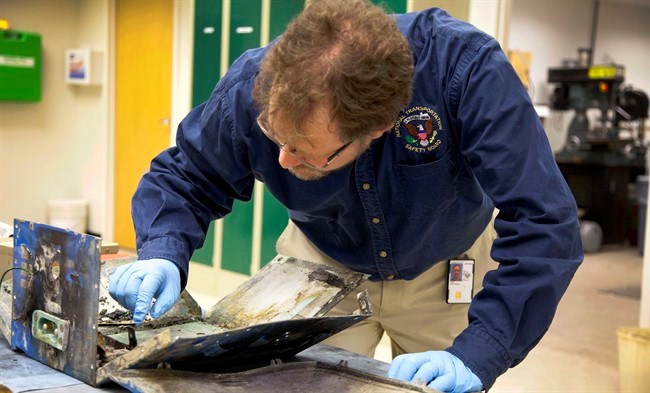WASHINGTON - The Boeing 787 Dreamliner battery that caught fire earlier this month in Boston shows evidence of short-circuiting and a chemical reaction known as "thermal runaway," in which an increase in temperature causes progressively hotter temperatures, federal accident investigators said Thursday.
It's not clear to investigators which came first, the short-circuiting or the thermal runaway, National Transportation Safety Board Chairman Deborah Hersman said. Nor is it clear yet what caused either of them, she said during a news briefing on the board's investigation.
The fire took place aboard a Japan Airlines 787 shortly after it landed at Logan International Airport on Jan. 7. All the passengers had left the craft, but a cleaning crew noticed smoke in the cabin 26 minutes after the plane arrived at its gate. It took firefighters nearly 40 minutes to put out a battery fire in the aircraft's rear auxiliary power unit.
Investigators are still dissecting the charred insides of the battery at the board's laboratory in Washington in an effort to piece together clues to the root cause of the fire. The focus of their painstaking work is a search for flaws in the battery that may have caused either the short-circuiting or thermal runaway.
The battery monitoring unit that might have provided answers was severely damaged in the blaze, Hersman said.
Investigators also tested the battery charger and another component related to charging. They found minor failures in both, but that would expected given the fire damage, officials said.
"We're still trying to determine the significance of those findings," Hersman said.
The Dreamliner, Boeing's newest and most technologically advanced airliner, was designed with safeguards aimed at preventing its two lithium ion batteries from catching fire, and containing a fire should one occur.
A little over a week after the fire in Boston, another 787 battery failure led to an emergency landing in Japan. There were no flames in that incident, but there was smoke in the cabin, Hersman said.
"The expectation in aviation is to never experience a fire on board an aircraft," yet there were two battery failures on the 787 within two weeks, Hersman said. "We have to understand why this battery resulted in a fire when there were so many protections that were to be designed into the system."
After the battery fire in Boston, the Federal Aviation Administration ordered a review of the design, manufacture and assembly of the 787. On Jan. 16, after the second battery incident, the agency grounded the six 787s operated by U.S. carriers, all by United Airlines.
Authorities in Europe and elsewhere — including Chile, Poland, Ethiopia, Qatar and India — swiftly followed suit. Two Japanese airlines had voluntarily grounded their planes before FAA's order. Overall, 50 Dreamliners have been grounded worldwide.
NTSB investigators are working with the FAA and Boeing in the U.S., as well as with aviation regulators and manufacturers in Japan and France.
"There a tremendous amount of work going on around the world," Hersman said.
The groundings have been a nightmare for Boeing, which competes with Airbus for the position of world's largest commercial aircraft maker. At the time of the groundings, Boeing had orders for more than 800 of the planes from airlines around the world attracted by the 787's increased fuel efficiency. The aircraft maker has said it has stopped delivering new planes to customers, although it is continuing to build them.
United received its first six 787s last year, and expects to get two more in the second half of this year, Jeff Smisek, the chairman, president, and CEO of United Continental Holdings Inc., said Thursday in a call with reporters.
"All new aircraft types have issues, and the 787 is no different. We continue to have confidence in the aircraft and in Boeing's ability to fix the issues, just as they have done on every new aircraft they have produced," Smisek said. United is working closely with Boeing and the FAA to return the plane to service, he said.
The 787 is the world's first airliner made mostly from lightweight composite materials. It also relies on electronic systems rather than hydraulic or mechanical systems to a greater degree than any other airliner. And it is the first airliner to make extensive use of lithium ion batteries, which are lighter, can hold more energy and are easier to fit into odd-shaped spaces in airplanes than other types of batteries.
The FAA certified the 787 battery system even though lithium ion batteries are more susceptible to catching fire when they overheat or short-circuit than other types of batteries.
Securaplane, an Arizona company that won a contract to design a battery charger unit for the Boeing 787, had a fire in November 2006 that ignited when the battery used by an engineering technician exploded during testing, destroying the firm's labs and production building, according to a summary of findings prepared by an administrative law judge who heard a whistleblower complaint filed by the technician. The technician went to court after he was fired.
Michael Leon, the technician, said he complained to his employer that the battery was damaged and unsafe and that there were discrepancies between the schematics and assembly documents used in building the battery charger. Administrative Law Judge William Dorsey, who heard Leon's complaint at trial, said in his ruling that one possible cause of the fire was Leon's misuse of the battery during testing.
The FAA investigated Leon's complaints in 2008 and 2009, the agency said in a statement. "The investigation determined that the battery charging units in the complaints were prototypes, and none are installed in Boeing 787 aircraft," the statement said. "Securaplane's production of a particular printed circuit board complied with FAA requirements."
___
Associated Press writers Joshua Freed in Minneapolis and Jacques Billeaud in Phoenix, Ariz., contributed to this report.
___
Follow Joan Lowy at http://www.twitter.com/AP_Joan_Lowy



